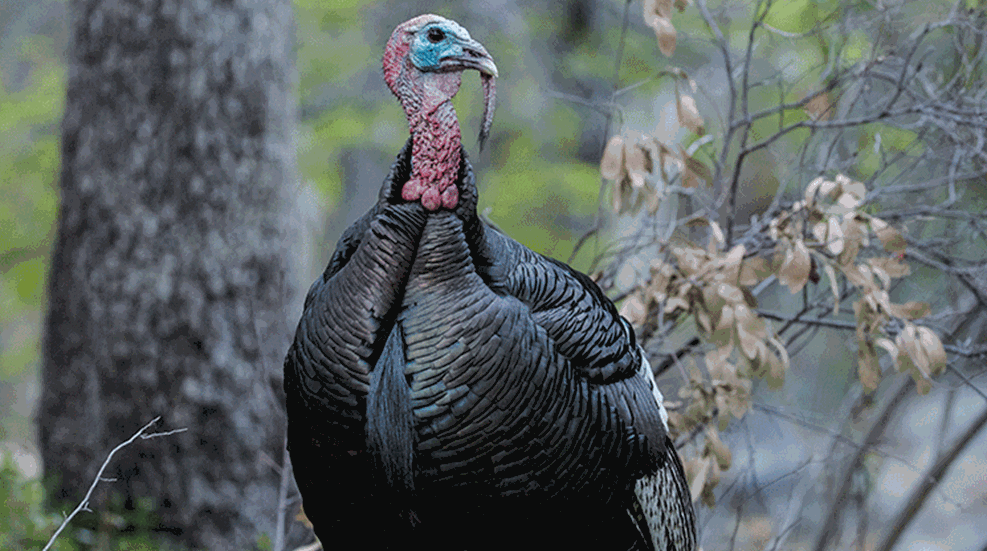
The first morning our pop-up was in the same open valley as the previous afternoon, just moved a bit closer to where numerous turkeys had bypassed us without comment. At dawn we heard a few gobbles, got a couple of responses—then nothing. An hour after full daybreak, in a major case of déjà vu, the same weird gobbler we’d seen the previous afternoon—mature body, but embarrassingly wispy little beard, no doubt suffering identity crisis—strode all the way up the valley and kicked the … well, you know … out of our decoys. He reminded me of the recently deceased Charles Manson, but we weren’t going to shoot him, so, to minimize damage, outfitter Ted Jaycox stepped out of the blind and shooed him away.
More time passed, as did the morning chill; Ted called conservatively (good) and far better than I could. Then, with the frost gone and the sun warming the blind, our little valley came alive. Gobbles to the left, gobbles to the right … into the Valley of Death strode the … suddenly amorous turkeys. They came from a distance, from two directions. What turned the switch I can’t say, but the first gobbler was a fine bird and we’d agreed Ken Perrotte was up first, so I relaxed … and Ken pasted the bird as it squared off with the decoys.
Maybe I relaxed a bit too much, because I wasn’t ready when a second, almost-equal gobbler rushed in, spurred Ken’s bird and then turned to the decoys. Ted gently suggested I should take him. Hmmm. Definitely my first Gould’s turkey, definitely my last of the “world slam” of North American turkeys … but also the first full day, and although a nice and very “shootable” gobbler, not a giant. On the other hand, the birds were acting weird! Decision made, I slowly raised the (marvelously) left-hand Mossberg pump gun, put the fiber-optic sights where the long neck joined the body and pressed the trigger.
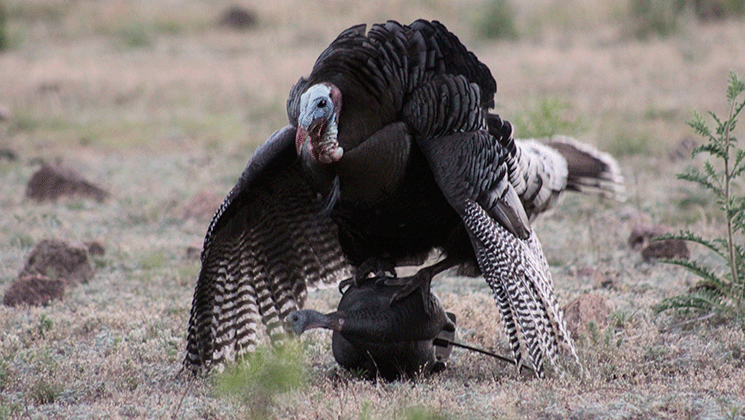
J. Gould’s Turkey
We all know (or at least believe) that the Eastern wild turkey was part of the first Thanksgiving feast in 1621. However, the actual type specimen of turkey (if one was present) may have been Meleagris gallopavo gallopavo, the southern Mexican turkey, identified in 1758 (by Linnaeus). This was the turkey taken back to Europe by Spanish explorers in the 1600s and brought back to the Americas by European settlers, scarce today and not recognized by the National Wild Turkey Federation (NWTF) as part of its “turkey slams.”
I was hunting neither of those birds. Gould’s turkey is the turkey of northwestern Mexico, identified by J. Gould in 1856 as M. g. mexicana. It is the largest of our turkeys, not necessarily heaviest because of its dry climate, but taller, with longer legs, bigger feet, and central tail feathers that are broader and longer. Gould’s turkey is an imposing bird, but is probably the least-known. There is a small population in southeast Arizona and southwest New Mexico, but it is primarily the bird of Mexico’s Sierra Madre range. It is found in at least eight Mexican states, pretty much along the spine of the Sierra Madres from the border deep into the interior. In the United States efforts are ongoing to rejuvenate a threatened population, but in Mexico Gould’s turkeys remain plentiful—far more plentiful than I realized!
Like the Merriam’s it’s a high-altitude bird, found generally from 4,000 to 6,500 feet elevation—like Coues whitetail—and sometimes to nearly 10,000 feet. Although larger, it resembles the Merriam’s turkey with white tailfeather tips, but the back feathers are more copper and green, lighter than the iridescent black of the Merriam’s.
The Last Turkey
Let me be honest: I am not a dedicated turkey hunter. Okay, with more honesty (ouch), I’m not a good turkey hunter, either! But I’ve been at it, off and on, for a long time. As a kid I participated in Missouri’s first modern turkey hunt, and I’ve been an occasional turkey hunter ever since. I’ve had my little Kansas farm for a decade, and my birds have made me better—but I’m still an amateur. Even so, I’ve done a lot of turkey hunting over the years, and in a lot of places.
It is not easy to obtain the NWTF “grand slam” of American wild turkeys: Eastern, Merriam’s, Osceola and Rio Grande. We can argue about which is harder, but I think it depends on where you live. Over time, living in the Midwest and the West, I took the Eastern, Rio Grande and Merriam’s turkey with greater or lesser difficulty. Florida’s Osceola gobbler was a son-of-a-gun, and not entirely because of distance. I think they’re just plain tough!
One of my better gigs in the Marine Corps Reserves was six months as Commander, Marine Forces, U.S. Central Command (MARCENT), in Tampa, Fla. When the season came in I hunted turkeys every weekend I could. I got a nice medal for the tour, but never a gobbler! That was 1998, and that wasn’t my first attempt at an Osceola gobbler. Clearly that one was my nemesis, but in years to follow I took a couple of big Osceola gobblers.
Of the “world slam” gobblers the other two are in Mexico. The ocellated turkey of the Yucatan Peninsula is so different that biologists (until recently) disputed whether it’s a subspecies or separate species, or even a unique genus. Almost as colorful as a peacock, with lots of blue in the feathering, the much smaller ocellated turkey is spectacular. The several times I’ve been down there I’ve been more interested in brocket deer and other jungle game. But I took an ocellated turkey, so at some point I simply had to have a Gould’s turkey, right?
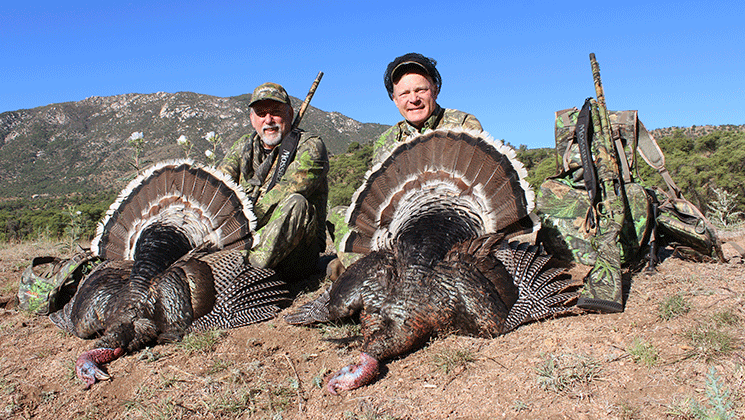
Mababi Ranch
It wasn’t a grand quest, honest, but it seemed an item that needed closure. And, like a lot of serious turkey hunters (which I am not), the Gould’s turkey of northwest Mexico was my last. I’d seen the tall, impressive birds in Chihuahua and Sonora on fall hunts for Coues whitetails but I’d never hunted them, and had no idea what a “proper” spring hunt was like. Also, like many of us, I have grown increasingly nervous about hunting in northern Mexico. But I wanted to hunt this turkey!
With Mossberg’s Linda Powell and fellow journalists Ken Perrotte and my old friend Gordy Krahn, I entered Mexico in Agua Prieta, below Douglas, Ariz. Outfitter Ted Jaycox of Tall Tine Outfitters is a turkey specialist, in the spring concentrating on our two most limited subspecies: Osceola in his native Florida then Gould’s in northern Mexico. Yes, we’d done our homework, but so had Jaycox: Clearance into Mexico, shotguns and all, was fast and hassle-free. From the border we drove south on blacktop for an hour then turned west toward higher, oak-covered ridges.
Shortly thereafter we rolled into Roberto and Alice Valenzuela’s Mababi Ranch, a well-watered and heavily timbered piece of the Sierra Madres that just might be one of the prettiest places I’ve ever seen. Some of the buildings date to the 19th century, when Apache raids were a grim reality; most would have hosted Pancho Villa and his Dorados a century ago. Roberto was raised on the ranch and educated in the States, where he met Alice. They were well into successful careers in Silicon Valley when Mababi Ranch needed a rancher. Deciding they’d rather raise their kids in the Sierra Madres vice suburbia, they packed up and assumed stewardship of Mababi. Today their children are well-educated and into their own careers, and Roberto and Alice, not just perfectly bilingual but equally bi-cultural, are still raising cattle and sheep (and turkeys and Coues deer) on the ranch.
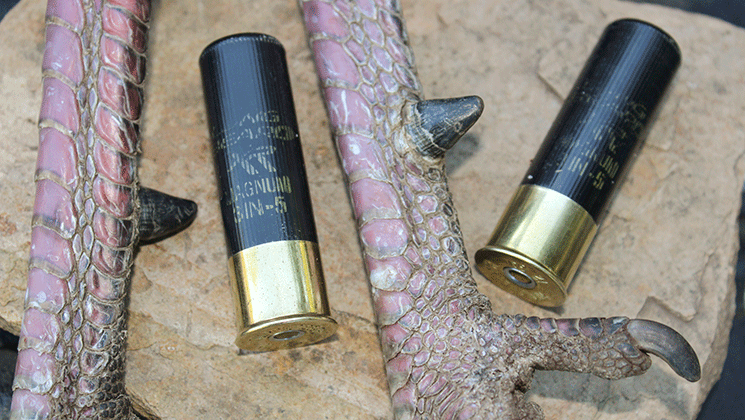
Shooting Too Soon
We arrived at the ranch at midday; there was plenty of time to get organized, check sights and patterns, and head out for an afternoon hunt. Ted took us to a long, narrow valley between ridges and we quickly set up a pop-up blind, put out a couple of decoys and climbed in to await developments. Late in the afternoon that weird gobbler with the wimpy adolescent beard made his first appearance, striding up the valley, soundly trouncing and unsuccessfully mating one of our decoys. He put on a hilarious show, but I wasn’t yet impressed. Quite a few turkeys, including some big gobblers, simply walked by us to the west, staying in the shadow of the ridge about 200 yards away. They ignored us, our decoys and our calls, going about the business of being turkeys in almost complete silence.
Jay told us there was a pond a bit to the north; most likely these turkeys would head there then work their way northwest and eventually go to roost up on the ridges. I suppose that’s what they did, but considering the number of birds we saw there wasn’t much talking going on, and very little gobbling toward roosting time.
It’s a huge mistake to judge any situation on the strength of one day—days vary—but I’d heard the Gould’s turkey is a vocal bird, and on that day these birds were anything but. The next morning we advanced our blind about halfway to the western ridge. At dawn there was a bit of gobbling, not much, and we had much the same situation: This time we had a feathered strutting jake as a decoy, and that same weird gobbler came in and attacked it until Jay chased him away. We had the same south-to-north and north-to-south movement to our west, now frustratingly and enticingly just out of range. But the birds walked on by without giving us a glance.
And then, as if someone threw a switch, Ken’s gobbler came in, trailed by mine. In seconds we went from rags to riches: two nice Gould’s gobblers with beautiful feathers, big heads and big feet. Except it was still the first day, and I had to wonder if maybe we’d shot too soon. That morning Linda and Gordy, hunting with guide Nick Forsythe, also doubled. In their thorny, rocky habitat Gould’s gobblers, despite their size, usually don’t have the longest beards or spurs, but Gordy’s was a monster.
Mind you, I wasn’t unhappy! The way my turkey hunting often goes I was delighted with a mature bird. But then Ted gave us the good news: He had tags left over, and anyone who wanted a second bird could keep hunting. Ken, Gordy and I wanted; Linda did not. But let me explain: Linda Powell is an exceptionally accomplished turkey hunter. This was her umpteenth (well, almost) collection of the six turkeys and she was happy. For the rest of us, these were our first Gould’s turkeys, and we wanted to see more.
By now we’d seen several bigger birds walk by out of range, and we’d also seen a big ball of gobblers at the south end of our little meadow. Ted figured we could take one more from this area, so we moved the blind southwest into a patch of cover in the lee of the ridge, hoping to waylay some of the birds that had been bypassing us. It was Ken’s turn again, so with a book I hunkered down in my corner of the blind.
Good thing, because it turned into a long day! We were clearly on Turkey Highway between water, roosts and preferred feeding areas. In small droves and singly, turkeys walked by us in the brush to the west, including a couple of big gobblers, but we were ignored and had no chance for a shot. Ted Jaycox knows his birds. His theory was that, unless something else happened, in the late afternoon that group of gobblers we’d seen to the south would head north toward water and walk right into our laps.
Right … and I could win Mr. Universe! Except those gobblers did exactly as Mr. Jaycox predicted. We watched them for two hours feed in some oaks at the end of the meadow. How many I’m not sure; more than a dozen. Despite enticing decoys and seductive calling they ignored us, “turkeying” around at 200 yards while we slobbered on our binoculars. Then, about an hour before sundown, they made up their minds and lined out straight toward us. I slunk back into the corner of the blind and froze—if this got messed up it wasn’t gonna be me!
We’d long since established the kill zone, and as they came Ken and Ted identified a big gobbler on our side of the group. He was about 25 yards out, pacing toward one of our decoys, when Ken flattened him.
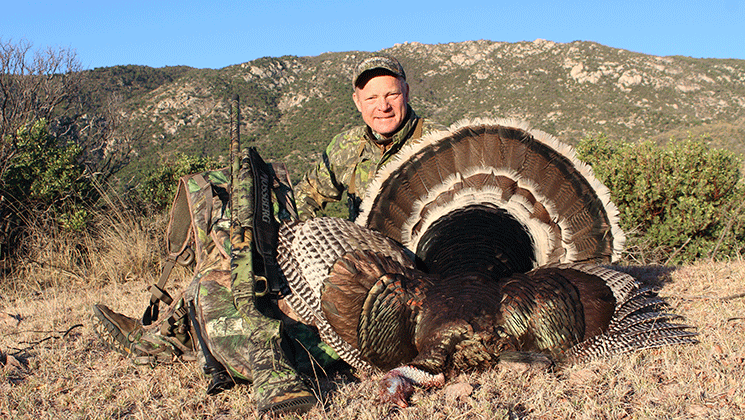
As Gould’s as it Gets
My turn again! At dark we roosted some birds up the main watercourse west of the ranch headquarters, maybe two-thirds of a mile southwest from where we’d been hunting. In a black and chilly pre-dawn, laden with blind chairs and decoys, Ted and I clambered down a faint trail to the canyon bottom, found a grassy little clearing and set up.
It was calm and cold, and on this morning birds were extremely vocal on the roost, gobbling like crazy in response to Ted’s owl hoot. I figured there was at least a half-dozen, seeming to be over a little finger to our left front, up a side canyon. The gobbling continued as the light grew, and although I didn’t hear them fly down I could tell the direction had changed. And then the sound dwindled as they moved away from us.
Ted and I shrugged at each other in the fast-growing light, and he made what sounded to me like very good hen-talk …
Our canyon was silent for nearly a half-hour, with sunrays now slanting over the ridges and through the trees. And then, to our left, a gobbler sounded off. Thunderously close, somewhere beyond a patch of thick brush. I pulled down my face net while Ted gave a soft cluck. The gobbler sounded off again, closer, and then I saw his black form slipping through the still-shadowed brush, thick beard swinging as he walked.
He came straight in, fast, and I shot him at about 18 yards when he faced our feathered Judas-jake. This was a bigger gobbler, a storybook finish to a storybook turkey hunt … except it wasn’t quite over. The shooting was finished, but we still had time so we set up in different areas and just watch turkeys. I suppose I hunted the Gould’s turkey because it was something I hadn’t done—and because I love the scenery, the food, the feel of a lonely ranch in the southwestern mountains. What I didn’t expect was for it to be one of the best turkey hunts of my life.





































